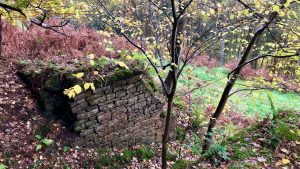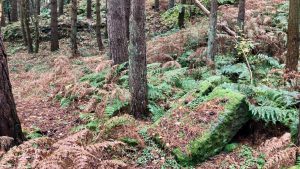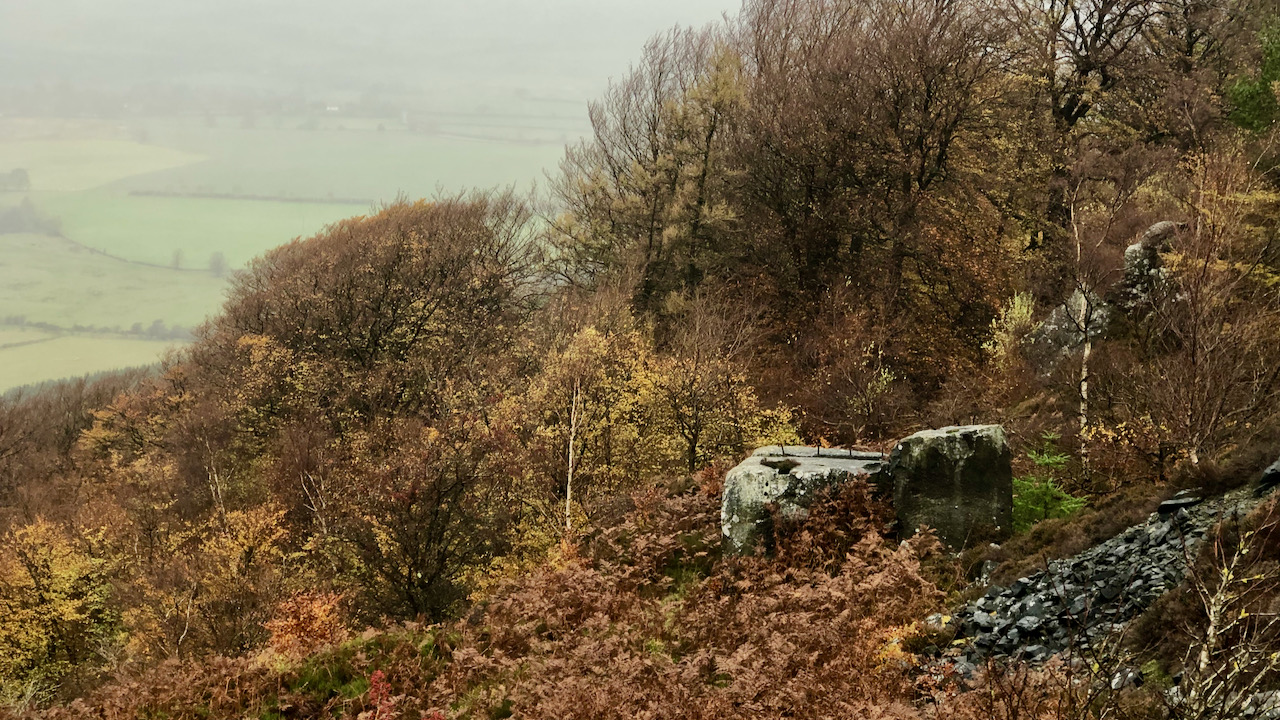Howling wind and relentless rain were more than enough to persuade me that a brisk walk on the open moor was no place to be. So, I cunningly decided to park up at Bank Foot and set out for a saunter in the sheltered woods that cover Ingleby Bank.

I soon found myself on the middle track, usually very muddy, and caught sight of the old tramway, complete with the abutments of an old bridge that once spanned it. I quick decision to follow the tramway up to the disused Park Wood freestone quarry at about 320 metres above sea level.
They called this Wren’s Incline, and it was easy to follow, especially in this season when the bracken is on the wane. The incline was used to lower hefty stone blocks down to the Rosedale Railway, where there were sidings and a row of a dozen workers’ cottages.
Now, it’s fair to say that the incline got its name from a certain Mr Wren, who made an attempt at running an ironstone mine in the area, which, it was reported, was “soon afterwards abandoned.”1The Gazette. (1883). Page 6651 | Issue 25299, 25 December 1883 | London … [online] Available at: https://www.thegazette.co.uk/London/issue/25299/page/6651/data.htm [Accessed 22 Oct. 2021]. This likely refers to the Ingleby Manor ironstone mine at Rudd Scar, which had a brief stint from 1856 to 1860.
So, it seems Wren then decided to give freestone or sandstone quarrying a shot. However, in 1884, the whole Ingleby Stone Quarry Company, including quarries, incline, blacksmith’s shop, offices, stables, cottages, and sidings, were put up for auction by order of the High Court of Justice Chancery Division, which handles business law, trusts law, probate law, insolvency, and land law2‘SALES BY AUCTION | Newcastle Journal | Saturday 12 January 1884 | British Newspaper Archive’. 2023. Britishnewspaperarchive.co.uk <https://www.britishnewspaperarchive.co.uk/viewer/bl/0000242/18840112/068/0002> [accessed 8 November 2023]. This court action stemmed from an action referred to as ‘Noble v. Coxton 1882‘. Sounds like some history worth delving into.

As I trudged up the incline, I stumbled upon a couple of rusty relics from the days of quarrying.
The sandstone block in the main photo, measuring 3 by 3 by 3 metres, has a top which has been squared off. It has four holding-down bolts intended to secure a winch of some sort. This imposing block is strategically positioned atop an incline, which intersects with the other incline at quite an angle. It is reasonable to assume that the sandstone blocks were transported down this incline using a tramway. However, I’m struggling to picture the specific procedure employed to transition from one incline to the other.
- 1The Gazette. (1883). Page 6651 | Issue 25299, 25 December 1883 | London … [online] Available at: https://www.thegazette.co.uk/London/issue/25299/page/6651/data.htm [Accessed 22 Oct. 2021].
- 2‘SALES BY AUCTION | Newcastle Journal | Saturday 12 January 1884 | British Newspaper Archive’. 2023. Britishnewspaperarchive.co.uk <https://www.britishnewspaperarchive.co.uk/viewer/bl/0000242/18840112/068/0002> [accessed 8 November 2023]

Leave a Reply